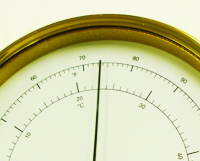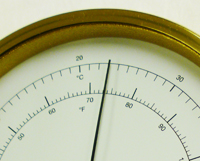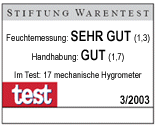"The Ship's Clock" Model 103PMU Click an image for a larger view Available from: |
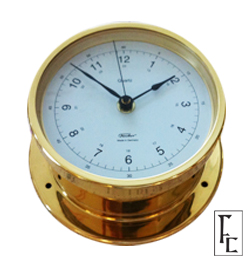 |
The Ship's Clock model 103PMU from Fischer Precision Instrument Company has a silent, high-precision quartz movement made in Germany. They are designed to withstand the vibration, temperature and humidity extremes expected on vessels at sea. It can operate accurately for up to 2 years on a single "AA" battery. The Fischer Ship's Clock is suitable for the enclosed bridge, pilothouse, or nav station of any vessel. Vibration-isolation bushings are included for bulkhead mounts. Optional plaque or mantel mounts are available. |
"The Ship's Thermometer" Model 103PMT Click an image for a larger view Available from: |
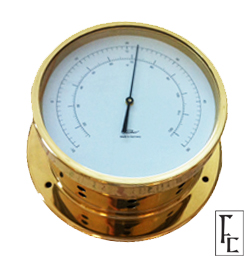 |
"The Ship's Hygrometer" Model 103PMH measuring range: 0 to 100% relative humidity Click an image for a larger view Available from: |
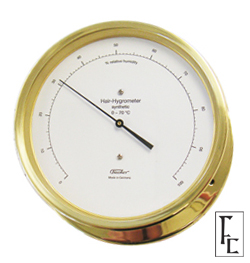 |
The Ship's Hygrometer model 103PMH is a precision all-mechanical hygrometer that offers accuracy as good as real hair hygrometer with much less maintenance. Intended for indoor use, above freezing level. Solid brass, base diameter 6.4 inches. Each instrument has a unique Serial Number and is tested at 3 points at the factory before shipment. They are then again tested relative to sling psychrometer at Starpath before shipping to customers. The Fischer Precision Instrument Company holds the same world leader position in hygrometers as they do in barometers. They have won high awards for the hygrometers in European consumer reports and testing labs. Each instrument has a unique serial number and is calibrated at two RH values before shipment.
Background This instrument measures the relative humidity of the atmosphere with high precision. Relative humidity is a crucial factor in weather analysis and forecasting and human comfort. The data are also crucial to the safe storage of many products. This purely mechanical instrument has been a prized product of the Fischer Precision Instrument Company for more than 60 years. It has no electronic components. The sensor element is a specially treated synthetic fiber whose length is sensitive to the humidity in the air. For a given tension on the fiber bundle, the length increases with increasing relative humidity. Changes in its length are then magnified with precision gears to display the relative humidity of the air. In contrast to real hair hygrometers, which must be chemically cleaned and rejuvenated often, this synthetic-fiber model provides high precision and fast response time with very little maintenance. Installation This instrument is intended for use indoors at air temperatures above freezing. For the best measure of the humidity, avoid placing the instrument in direct sunlight or in line with strong breezes. Locate the instrument in a place that best represents the average temperature of the local environment. Avoid outside walls that might be cooler than average, and avoid direct exposure to heat sources that would be warmer. Maintenance Although it is not strictly needed, if you desire to have the best results and to be confident of your results, it will be beneficial to rejuvenate the fibers once or twice a year. This is best done by placing the instrument in a sealed plastic bag with a small container half full of water. A large freezer bag and a shot glass or demitasse cup will to the job. Then let the sealed bag sit over night. This is an easy process and preferred to other methods. In any event, do not let the instrument come in contact with hot water or with steam as that could permanently deteriorate its performance. On the next day the insrument should read in the 94-to-98% RH range. This rejuvenates the fibers and provides a high-end calibration point on the instrument. If you note that it reads below 96, then consider the difference as the offset of the instrument and apply this correction to readings at lower RH values. The Fischer instrument has an adjustment screw available in one of the ventillation holes on the bottom of the case that cane be used to correct for the offset. Remove the instrument from the bag and wait several hours till the instrument comes back to stable ambient RH reading before making the adjustment. If it read 92 % at saturation, then it is nominally 4% low, so if the ambient RH reads 45% it should be increased to as close to 45+4 = 49 as possible. All Fischer instruments are individually calibrated at two RH values before shipement, so they should read the proper saturation value. ______ For home use, if you have the average seasonal variations indoor humidity of say 75% to 50% in the summer and 40% to 25% in the winter, then a good time to rejuvenate would be in the beginning of winter and beginning of summer when the relative humidity is crossing over the 50% range. For use at sea underway, you might just choose two dates to make the rejuvenation such as the two solstices. Healthy room environment It is often considered that 40% to 60% is a healthy and comfortable relative humidity range, and with a hygrometer showing the actual value you may find that added moisture in the winter would be beneficial. See Starpath Notes on Humidity for more details. |
